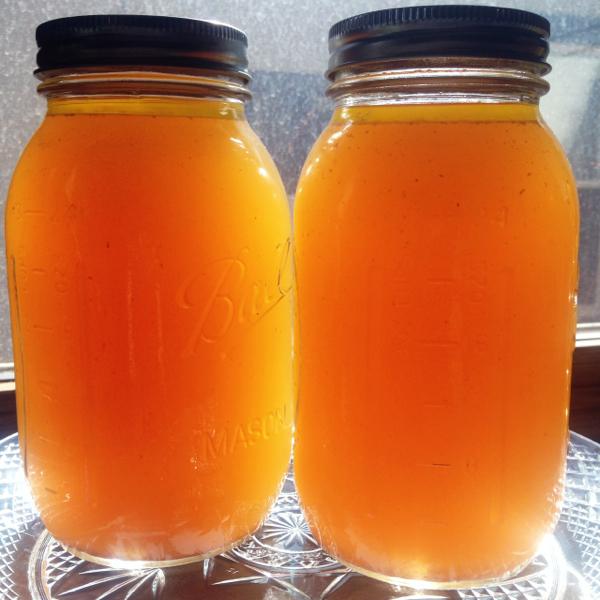Whether you’re testing out this Paleo business, diving into the autoimmune protocol or, like me, are trying to reduce waste and use every part of the animals that you buy, bone broth seems to be one of the buzz terms in health food right now.
So what is it and why should you be on the lookout to score your own chicken feet and beef knuckles as soon as possible?
Here’s your Bone Broth 101.
What is bone broth?
Simply put, it’s a mineral-rich broth made by slowly cooking a big batch of bones in water until as many of the minerals as possible have been leeched out of those bones and into the liquid. It’s different from a stock in that it’s cooked much longer and often with added parts, like chicken feet, to maximize its gelatinous, nutritious wonder.
Why bother?
Reputable sources (think Mark’s Daily Apple and ChrisKresser.com, to name a few) report that bone broth contains calcium, magnesium, phosphorus and sulfur, as well as other trace minerals, that are all easily absorbed by our bodies. On top of that, the broth seems to aid digestion and help us build a “healthy gut” complete with all of the enzymes we need to move things along in proper fashion. Stronger teeth and bones have been linked to regularly drinking the broth, as has relief from arthritis and other inflammatory conditions. While there hasn’t been much in the way of scientific study to support this, the anecdotal evidence is plentiful. Starts to make you wonder who wouldn’t want to replace a tiresome supplement regiment with a warm cup of natural, homemade broth.

Where am I supposed to find all those bones?
Making bone broth correctly requires a lot of bones. Sources agree on two to three pounds per gallon of water. The easiest way to get these bones is to save them from the other meals you cook. But this may take a while and, depending on how strong your itch is to get started, you may not have the patience for it. I learned from asking around at couple of local grocery stores that most do not butcher on site (even if they have a butcher’s department) and so therefore don’t typically have any “extra” bones lying around to sell to you. Small butchers, co-ops, and farmer’s markets are your best bet for finding lovely carcasses or bags of skeletal remains. The Wedge Community Co-Op, Seward Community Co-Op, Mississippi Market, and Braucher’s Sunshine Harvest Farm are few of the places I confirmed parts in stock.
What else will I need?
Before you start cooking, there are a few steps for preparation. First, you’ll need a large stock pot and/or a sizeable slow cooker. You’ll also need a fine-mesh sieve. A ladle and some glass jars or freezer-friendly storage containers will be helpful, too.

Additionally, you’ll want some vegetables and spices to flavor the pot. I like to save the cuttings from organic onions, carrots, and celery when I’m cooking. I stick them in a gallon-sized freezer bag and then when the bag is full, I’m ready for broth making. You can also just chop up a big onion and a couple of carrots and celery stalks. A few bay leaves and a handful of black peppercorns can also be added. Parsley and other fresh herbs are good, too, but should be added near the end of your cooking time, say 20 minutes prior to being done, to keep from turning things bitter.
A couple of tablespoons of apple cider vinegar will aid the process of breaking down the bones and drawing out the good stuff.
What’s the process?
You’ll want to start by roasting your bones if they are raw. You don’t have to. It’s safe to put the raw bones in a pot, cover them with water and start cooking. But it will smell like a big pot of rank stinky feet for the first few hours. And since you’ll be cooking the broth for a day or more, you, and your neighbors, may not want to deal with that.
Beyond the smell, raw bones don’t produce as rich of a flavor as roasted bones, and since you’ll want to enjoy this broth by the steamy mugful, you want to get as much flavor in there as possible.
Depending on the type of bone, the roasting time will vary. I typically start with raw chicken carcasses and roast them at 400 degrees F for 30 minutes. For larger beef bones, you may want to aim closer to an hour on roasting time.
 Simmer for how long??
Simmer for how long??
Add roasted bones, chicken feet (one or two, if you’re using them at all) vegetables, spices, and vinegar to a large pot and cover with cold water. Bring it all to a boil and then reduce the heat to low and simmer. And simmer. And simmer. For chicken bones, the recommended cooking time is 24 hours; for beef, upwards of 48. When finished, what’s left of the bones will basically crumble in your hands because every bit of goodness has been cooked out.
If you watched a lot of Public Service Announcements as a kid and feel funny about leaving your stove unattended overnight, feel free to do this in a slow cooker, if you have a big one. Or start it on the stove and then transfer it to a slower cooker (or two) before you go to bed.
Depending on how clean your bones and vegetables are, you may have to skim impurities from the broth during the first few hours of cooking. Check in every hour or so and skim any greyish, frothy bits that rise to the top. I find using organic, chemical-free ingredients nearly eliminates this step.
Okay, wrap this up.
When you’ve reached your optimal cooking time, simply strain the broth through a fine sieve. Discard the nasty bits and store or freeze the rest to use in a variety of recipes, as you would any other broth or stock. You can also just drink it daily on its own.
When you cool it in the fridge, it may turn the consistency of a soft-set jelly. This is due to the gelatin from the bones, and means you have a rich broth. It is more apt to happen if you add in something like chicken feet, and is perfectly normal, even ideal. Don’t panic if it doesn’t happen though. If you followed the steps above, you still have a perfectly good, nutrient-packed broth.
And it’s as easy as that. Our grandmas have been telling us for generations about the healing powers of brothy soups and now we seemed to have tuned in to what’s at the heart of that. Whether it’s the latest health fad or not, there doesn’t seem to be any harm in trying it. So start your pots a’ simmering.
 Christina Vanoverbeke is a Minneapolis transplant, by way of Youngstown, Ohio, and Phoenix and Tucson, Ariz. She is a reformed newspaper reporter turned freelance Jill of all trades. She works in health and wellness fundraising by day and runs the cooking blog Cautiously Domestic by night. Look for her in your local farmer’s market – she’ll be the one talking some patient farmer’s ear off.
Christina Vanoverbeke is a Minneapolis transplant, by way of Youngstown, Ohio, and Phoenix and Tucson, Ariz. She is a reformed newspaper reporter turned freelance Jill of all trades. She works in health and wellness fundraising by day and runs the cooking blog Cautiously Domestic by night. Look for her in your local farmer’s market – she’ll be the one talking some patient farmer’s ear off.

